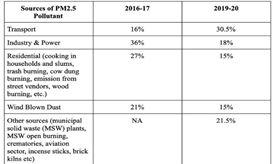

Context
A report released by the NITI Aayog, highlights the use of Carbon Capture Utilisation and Storage (CCUS) Technology in promoting the low carbon-hydrogen economy and in removal of the CO2 stock from the atmosphere.
Key highlight of the proposal:
- Title: “Policy framework of the CCUS” prepared by the NITI Aayog
- As per the report, the usage of CCUS Technology has a critical role to play for the country to halve CO2 emissions by 2050.
- Application: This technology is used for decarbonising carbon dioxide (CO2) from high polluting sectors such as steel, cement, oil, gas, petrochemicals, chemicals and fertilisers.
- The key to a successful CCUS implementation in India was to enact a policy framework that supported the creation of sustainable and viable markets for CCUS projects.
- Suggestion: CCUS policy should be carbon credits or incentives based, to seed and promote the CCUS sector in India through tax and cash credits.
Significance of the proposal:
- Inclusion of Private sector: The private sector is unlikely to invest in CCUS unless there are sufficient incentives or unless it can benefit from the sale of CO2 or gain credits for emissions avoided under carbon pricing regimes.
- Enable to track the major emitters: Via using the inclusion of various parties, it will become easy to track the major emitter of Carbon-dioxide.

The Carbon Capture Utilisation and Storage (CCUS) Technology:
- The technology is designed to tackle global warming by capturing CO2 at power stations, industrial sites or even directly from the air and permanently storing it underground.
- Carbon sequestration describes long-term storage of carbon dioxide or other forms of carbon to either mitigate or defer global warming.
- It has been proposed as a way to slow the atmospheric and marine accumulation of greenhouse gases, which are released by burning fossil fuels.
|
There are number of technologies for sequestering carbon from the atmosphere. Some of these are:
|
Need to Capture Industrial Carbon emissions:
As the key points suggested by Emission Gap Report 2022, there is a dire need to address industrial pollution:
- Problem statement: The world is not on track to meet the targets outlined in the 2015 Paris Agreement.
- By 2100, the existing policies will cause a 2.8°C increase in temperature. By the end of the century, the temperature increase will only be limited to 2.4 to 2.6°C if present climate promises are implemented.
- Suggestive Measures:
- Change in system: An urgent system-wide change and an unprecedented decrease in GHG emissions over the course of the coming years (by 2030).
- Emission cut: To meet the targets set forth in the Paris Agreement by 2030, GHG emissions must be cut by 45 percent.
- Major areas: The most recent study called for corrective measures in six areas, including the production of power, the building and transportation industries, and the food and financial systems.
- Finance: It predicts that 4 to 6 trillion USD would be needed to be invested annually for the world to transition to a low-carbon economy.
- Carbon pricing: Carbon pricing and the development of a market for low-carbon technologies are the best corrective measures.
Recent Government Interventions:
- Nationally Determined Contributions (NDCs): There are three goals:
- Reducing the emission intensity of GDP, by 33-35% by 2030 from the 2005 level;
- Achieving about 40% cumulative electric power installed capacity from non-fossil fuel-based energy resources by 2030; and
- Creating an additional carbon sink equivalent to 2.5 to 3 billion tonnes of CO2 through additional forest and tree cover by 2030.
|
- Reforms in Transport Sector: India leapfrogged from Bharat Stage-IV (BS-IV) to Bharat Stage-VI (BS-VI) emissionnorms by April 1, 2020, the latter being originally scheduled for adoption in 2024.
- India's Support to EVs:India has taken various measures to develop and promote the EV ecosystem:
- The remodelled Faster Adoption and Manufacturing of Electric Vehicles(FAME II) scheme
- Production-Linked Incentive (PLI) schemefor Advanced Chemistry Cell for the supplier side


